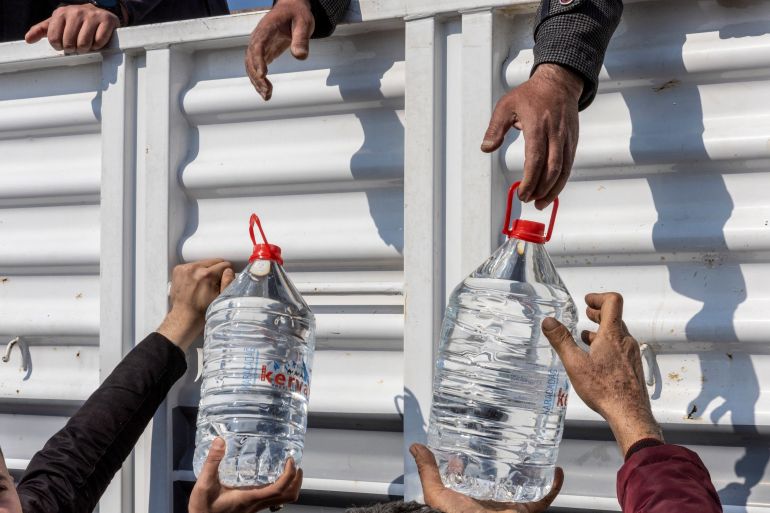In scorching, earthquake-ravaged Hatay, water shortages lead to illnesses
Authorities, however, point to widespread destruction, low funds and dwindling outside help as obstacles to their work.

Istanbul, Turkey – On a dusty patch of land on the outskirts of Antakya, southern Turkey, hundreds of people who survived February’s earthquakes now queue for water under the scorching sun.
Across the disaster-hit region, water has become a precious commodity as authorities battle to repair ruptured pipes and other damage to the water infrastructure.
Keep reading
list of 4 items100 days after the quakes, Turkey’s children are still suffering
Syria extends permission on post-quake aid border crossings
Turkey’s Antakya gears up to vote amid earthquake devastation
In Antakya, the capital of Hatay province, the difficulty accessing one of life’s basic necessities has been exacerbated by a Mediterranean heatwave that has seen temperatures soar above 40 degrees Celsius (104 Fahrenheit).
For those living in tents and containers – provided as temporary accommodation following the quakes six months ago – the heat has been compounded by clouds of dust thrown up by demolition work across the city.
“We are experiencing water, food and hygiene problems,” said Ayhan Tekin, 43, after collecting a dozen bottles of water from the distribution point. “We can’t get out of the dust and smoke.
“We can’t take a shower. When we come home in the evening, we realise how precious it is to take a bath. We can’t do any cleaning. Flies and pests infest everywhere.”
The shortage of water for drinking, cooking and cleaning since the February 6 earthquakes, which killed more than 50,000 people in Turkey, and at least 8,000 in Syria, brings with it illness. The dusty conditions carry the risk of serious long-term respiratory conditions.
“The biggest problem we have here is not using water while removing the rubble and demolishing buildings,” said Sevdar Yilmaz, the head of Hatay Medical Chamber, referring to the lack of water usually used to dampen down dust thrown up during demolition.
“This will cause many diseases in the future. Eye complaints, throat complaints and complaints, such as coughing and shortness of breath, are already common.”
In the future, disorders such as asthma are expected to rise, while the incidents of longer-term diseases such as lung, throat and laryngeal cancers are expected to rise. The immediate issues, however, have been illnesses, such as diarrhoea, due to a lack of hygiene, Yilmaz said.
“Inspections are not carried out adequately in places where communal meals are eaten,” he added. “We have seen people who eat at some of the same places get symptoms of poisoning.”
Water provision
While handing out bottled water has been a short-term fix, the pressing necessity is providing drinkable mains water.
Hatay municipality’s water and sewage agency, HATSU, has come under criticism, including from locals who have complained that they still have to travel long distances to collect bottled water.
The authorities, however, said they were overwhelmed with infrastructure projects and that the widespread destruction, movement of people, lack of funding and dwindling outside help were factors standing in their way.
“We are working with a workload more than 12 times greater than before the earthquakes,” HATSU General Manager Ikbal Polat said.
“The city has infrastructure and water problems. Even though HATSU is an earthquake-affected institution, it still works. I understand the reaction, problems and anger of the people of Hatay. There are shortcomings but we are doing our best.”
Polat pointed to the agency’s lack of income as a result of its reduced customer base since the quakes, as well as the strain of laying pipes to supply container and tent “cities”, as among the major problems it faces.
“We currently have requests for sewer connections for 2,000 container homes in various areas,” he said. “Our workload exceeds HATSU’s capacity and our team is struggling to cope with it.”
While aid flooded into Hatay and the 10 other affected provinces in the wake of the earthquakes, this has slowly drifted away, according to health chief Yilmaz.
Some 110 municipalities from outside the earthquake zone sent manpower and supplies initially but only 30 are still helping, he said.
“It is not possible for Hatay Metropolitan Municipality to do this job alone. Serious outside support is needed in order for the infrastructure to become functional again.”
Not enough support
Hatay Mayor Lutfu Savas said HATSU had not received any income in the four months following the quakes and its number of customers had dropped by 40 percent.
“We continued to work under those conditions but we do not have the chance to fight the increasing problems and costs on our own,” he said. “Water sources disappeared, wells dried up. There were breaks in the main lines.”
AFAD, the government’s aid coordination agency, did not immediately respond to a request for comment about the level of support to quake-hit municipalities.
Water shortages are not just an urban problem. Gul Basaran, 35, lives in a tent with her four children outside the town of Samandag, on Hatay’s Mediterranean coast, after their home was destroyed.
“My children are nauseous, I am afraid they will be poisoned,” she said. “We meet our water needs with the water coming from the mountains but the water flows very little. We wait 20 minutes for five litres of water.”
“May God not put anyone in the situation we are in. I really don’t know what to do.”
Even those whose homes were unaffected by the tremors have experienced water problems.
Adnan Ozcelik, a civil engineer, said he still does not receive water at his undamaged property in Antakya.
“There is a call [for people] to ‘return to Hatay’, but there is no water, how can they return?” he said. “Also, the water bill came in recently. They want money for a service we did not receive.”